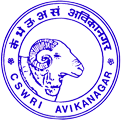|
|
|
|
|
 |
|
 |
|
Grassland and Forage Agronomy Section
- Ardu (Ailanthus excelsa) based three-tier agroforestry system for maximizing food and fodder production in semi-arid regions
- Average Productivity (Dry fodder yield, Grain yield and Biomass yield) of various crops was significantly higher in three tier agroforestry system which was higher by 4.71 and 12.95 percent in dry fodder yield. 5.47 and 22.57 per cent in seed yield and 4.85 and 14.34 per cent in biomass yields in comparison to two tier agro forestry system and open field condition. The cenchrus biomass production was higher by 3.85 and 17.28 per cent in three tier system in comparison to two tier system respectively.
- Establishing pasture and silvi-pasture through soil & water conservation at sloppy degraded lands.
- Under soil and water conservation measures V-ditch contour bunding was an effective soil and water conservation measures in establishing cenchrus pasture at sloppy degraded lands in semi-arid regions. At lower riches of sloppy degraded land, higher soil moisture status resulted in higher production of cenchrus as compared to upper riches.
- Management of salt affected lands by Gypsum and FYM for soil health and higher fodder production in semi arid regions.
- Application of gypsum and FYM brought about considerable improvement in soil pH, organic carbon and bulk density and growth and yield of both the crops i.e. moong and mustard as compared to control. Application of these soil ameliorants caused reduction in soil pH, increase in organic carbon and slight reduction in bulk density and thus improving soil physico-chemical properties for better growth and yield of crop plants.
- Establishment of horti-pasture system for semi-arid region
- In mixed pasture of grass Cenchrus setigerous and legume Dolichos lab lab (1:2 row ratio), incorporation of ber and aonla as fruit tree in the configuration of 8 X 8 sq. meter resulted into higher returns than sole pasture without affecting the forage production.
- Mixed cropping and forage quality improvement
- Annual legume like Cowpea, Guar, Moth and Perennial legumes like Dolichos, Clitoria, Siratro, Stylosanthes and Atylosia can be incorporated as a mixed crop in pasture. This not only increases total biomass but also provide quality forage from grass-legume mixed pasture.
- Lopping management of fodder trees
- Ardu (Ailanthus excelsa) can be lopped fully twice a year in the month of December and May-June at any stages of its age. While, fully-grown neem is lopped fully once in a year in the month of December-January. However, young tree of neem can be lopped fully twice a year in Dec.-Jan. and May-June. Reverse is true for Khejri. Young Khejri plant can be lopped fully only once in a year, however, full-grown tree/age old tree can be lopped two-third twice a year in May-June and Nov.-December.
- Maximization of pala production through agronomic practices in mixed pasture.
- Pala (Zizyphus numularia) is a nutritious fodder for sheep in arid and semi-arid area. Tiller cultivation with phosphorus application (40 kg P205/ha) after bush cleaning is the best agronomic practice for maximizing pala (Zizyphus numularia) production (16.17 q/ha) and total biomass production (36.15 q/ha) in mixed pasture of Zizyphus nummularia and Cenchrus spp.
|
|
|
 |
|
 |
|
|
|
|
|


